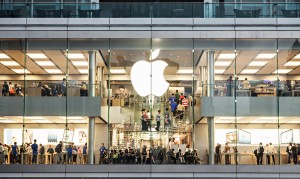While it might seem that being awarded a contract by Cupertino-based electronics giant Apple Inc. would be a ticket to “easy street” for any company, the reality is much more complex, as revealed by the case of Japan Display. According to a Reuters report, Japan Display makes approximately a third of its revenue by producing iPhone screens for Apple, and that this share is rising despite its efforts to find other customers.
Apple Inc. (AAPL) is famous for its hefty margins, one of the reasons why its cash reserves are ample and its stock remains attractive to investors. However, these large margins are built on a foundation of companies whose profits are pared to a bare minimum in order to satisfy the demands of Apple for high quality components at the lowest possible price. The brainchild of Steve Jobs is relentless in demanding low prices from its suppliers, including Japan Display.
 Japan Display also suffers from its dependence on Apple’s cyclical product release model. Major releases occur only sporadically, leaving long cash droughts in between these brief spikes of massive activity. While Apple itself bridges these gaps with retail sales of existing stock and the provision of various services (including its lucrative app store royalties), Japan Display is often left high and dry during these periods, posting losses during “off-cycle” periods and then moving back into the black when the next major product release occurs.
Japan Display also suffers from its dependence on Apple’s cyclical product release model. Major releases occur only sporadically, leaving long cash droughts in between these brief spikes of massive activity. While Apple itself bridges these gaps with retail sales of existing stock and the provision of various services (including its lucrative app store royalties), Japan Display is often left high and dry during these periods, posting losses during “off-cycle” periods and then moving back into the black when the next major product release occurs.
In short, the internal fiscal ecosystem of a company like Japan Display – one of Apple’s many suppliers – does not resemble a lush, year-round jungle. Instead, it is more like a desert, dry and parched for much of the year and then blossoming briefly and intensely after rare annual rainfall.
Of course, there are secondary benefits to be had from dealing with one of the world’s most powerful electronics companies. Japan Display probably has little trouble obtaining loans to tide it over the rougher periods, since it can show potential lenders orders for tens of millions of screens on its books. It likely also attracts more investment capital than would be the case were it not affiliated with Apple (AAPL), and thus sees its stocks bid higher.
Japan Display has attempted to lessen its dependency on Apple by cultivating more orders from Chinese smartphone makers. However, profits have proven elusive on this front also. Though less cyclical, the margins on these orders are also very low – not necessarily because of an aggressive bargaining policy like that pursued by Apple, but because the small manufacturers it deals with simply cannot afford to pay more.



